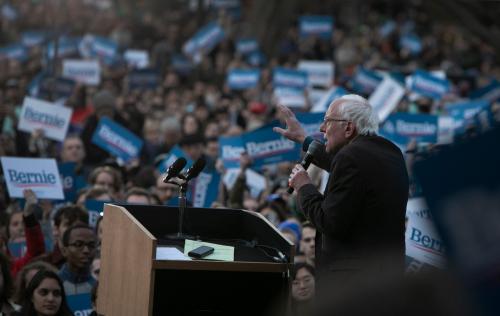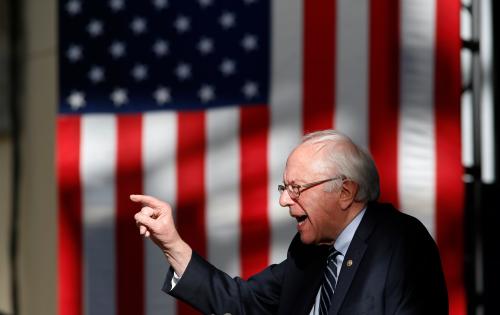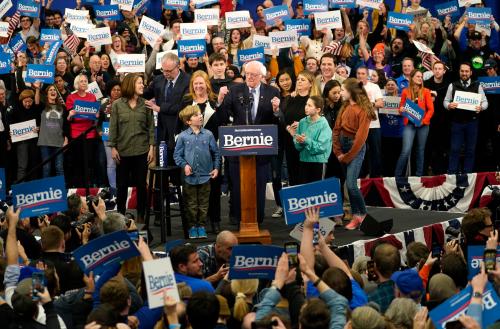Senator Bernie Sanders entered the 2020 Democratic primary race with a wind at his back. With a narrow loss to Hillary Clinton in 2016 and a massive political organization, Mr. Sanders set the tone for the policy conversation in the race. Soon after announcing, the Vermont senator began raising record amounts of money, largely online and in small-dollar donations. Millions of donors provided the campaign with a target list for future donations, volunteers, and a network of political supporters. But by the middle of March it became clear that Sanders would be, once again, the runner-up. So what happened?
Bernie by the numbers
An important place to start is at the numbers themselves.[1] As I have written previously on this blog, Mr. Sanders failed to deliver the voters he promised. Namely, he argued that liberal voters, new voters, and young voters would dominate the political landscape and propel him and his ideas to the nomination. However, in nearly every primary through early March, those voters composed significantly smaller percentages of the Democratic electorate than they did in 2016.
Yet, Mr. Sanders’s underperformance is deeper than that. As the figure below shows, in the first four primaries and caucuses Mr. Sanders ran behind his 2016 totals—often by significant margins. That deficit continued into Super Tuesday’s 14 contests, where Mr. Sanders ran behind his 2016 levels of support by an average of 19.4%. One common argument to excuse this underperformance centers on the crowded Democratic field. Some claim it is unfair to expect Mr. Sanders to do as well in a multi-person race as he did in a two-person race in 2016.

However, there are data to undermine that claim. First, in this year’s Nevada caucuses, Mr. Sanders came within 0.4% of his 2016 total, during a period in which no major candidate had dropped from the race. Second, in Vermont, Mr. Sanders’s home state—one in which you would expect his support to be quite stable—he was barely able to capture a majority of the vote in 2020 (50.7%), while dropping 35.4 points from 2016. Finally, and most damaging to the “crowded field defense,” there have been nine primaries since Elizabeth Warren dropped out of the race on March 5th, leaving it a two-person race. In those nine primaries, Mr. Sanders underperformed his 2016 totals by an average of 16.0%, including losing three states that he won in 2016 (Idaho, Michigan, and Washington).
The map below provides the change in Mr. Sanders’s support between 2016 and 2020 in each of the 27 states that have thus far voted. These data provide a more detailed and starker look at the Vermont senator’s struggles this primary season. In every one of the 27 primaries and caucuses thus far, Mr. Sanders underperformed his 2016 level of support. That ranges from the narrowest margin of 0.4% in Nevada to the largest margin in Utah where his support dropped from 79.3% in 2016 to 34.8% in 2020.
 Overestimating Sanders’s appeal
Overestimating Sanders’s appeal
A large part of the reason for Mr. Sanders’s failure to capture the 2020 Democratic nomination rests in a misunderstanding of his 2016 appeal. Many supporters and observers looked at the 2016 primaries—in which Mr. Sanders won about 43% of the popular vote—and concluded that the Vermont senator had broad-based appeal indicative of a party that was moving left. That Monday-morning quarterbacking from Mr. Sanders’s supporters included claims of a rigged process and the early intervention of superdelegates that propped up Mrs. Clinton’s candidacy and suppressed his support.
However, another explanation could be that Mr. Sanders’s level of support was artificially inflated in 2016. Rather than casting votes in favor of the senator, voters could have been looking for a Clinton alternative and Sanders was their only option. Whether it was Clinton fatigue, Mrs. Clinton’s policy positions and decisions as the former Secretary of State, allegations made about her tenure as Secretary of State, sexism, or some other reason, some Democratic voters may have wanted to protest her candidacy and they landed on Bernie Sanders.
This outcome likely boosted the Sanders campaign’s assessment of its own appeal and ability to translate that into votes. This was, of course, buoyed by Mr. Sanders’s favorability ratings among democrats, which continued into this cycle. Even having a heart attack in the middle of the 2020 campaign did not seem to impact his appeal. However, the approval rating of a senator and the public’s willingness to nominate that person to be the party’s standard-bearer may not be synonymous.
A few things are certain about Mr. Sanders and the Democratic Party between 2016 and 2020. The party became more liberal. Mr. Sanders has not dramatically changed his positions on issues—a point of pride for the Vermont senator. If those votes cast for Mr. Sanders in 2016 were an honest reflection of the public support for him and his ideas, much of that should have carried over four years later as the party moved left. They did not.
Instead, the Sanders campaign believed that cushion of support from 2016 would be sufficient to propel him to the nomination, and mistook a record number of small-dollar donors for broad appeal. These errors closed off the true path to the nomination: broadening the reach of his message, reaching out to anti-Clinton voters who may not have been true supporters, and building a diverse coalition within the Democratic Party. And as a result, Mr. Sanders’s underperformance in 2020 means that he will spend the summer and fall as a surrogate rather than a standard bearer.
The Brookings Institution is committed to quality, independence, and impact.
We are supported by a diverse array of funders. In line with our values and policies, each Brookings publication represents the sole views of its author(s).









Commentary
Why Bernie Sanders vastly underperformed in the 2020 primary
March 20, 2020